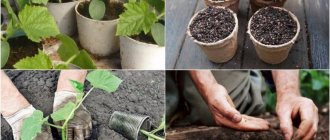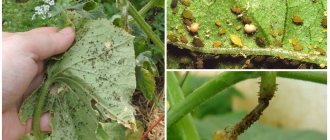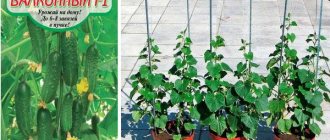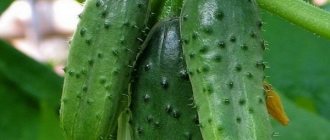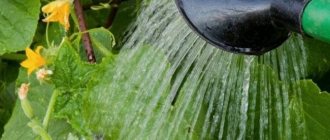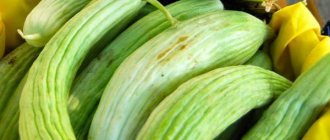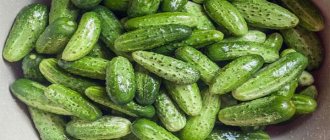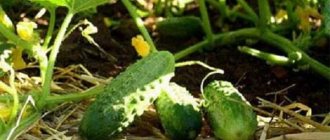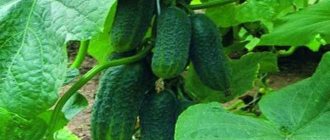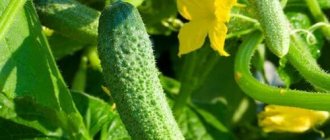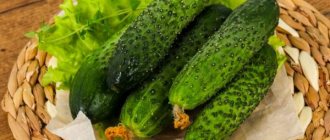The Forsage cucumber was bred by breeders and is a new generation hybrid. This is indicated by the F1 in its name.
The variety shows high resistance to diseases and is intended for planting in many regions of the country, including risky farming areas. The plant is an early ripening species, but is characterized by stable, long-term fruiting and high yield.
The variety is included in the breeding State Register of Russia.
Description of cucumbers King of the Market
Cucumber King of the Market f1 is a mid-season crop variety, the first harvest of which is harvested 40-44 days after the seedlings hatch.
The variety is intended for cultivation in open and covered (early spring) beds. Plants The King of the market is parthenocarpic with a predominance of female inflorescences. The ovaries are arranged in a bouquet manner, so up to 3 cucumbers are formed in each bosom. Gherkin fruits grow up to 10 cm in size. The skin of the cucumber is dark green in color with small white spines and abundantly located tubercles. King of the Market cucumbers are intended for fresh use and for canning.
Characteristics of cucumber Forsazh
Once farmers are planning to plant cucumbers in their garden, they prefer to use hybrid seeds that have an early ripening time. The cucumber Forsazh f1 belongs to such crops. It has not only early ripening, but also high taste and quality of fruits.
Characteristics of cucumber Forsazh
Characteristics of the variety
Fast and Furious F1 was developed by breeders of the Russian Federation in 2004. Literally 3 years later, this type of cucumber was included in the national register of Russia. Breeders made sure that this variety showed high resistance to diseases and pests.
Forsazh f1 is ideal for growing in all regions of the country. Regardless of climatic conditions and soil indicators, productivity is always at a high level.
This hybrid variety is early ripening. Its growing season is about 40 days. For this reason, it can be grown not only in greenhouses, but also in open areas. This type of cucumber can self-pollinate, so it does not need the help of bees or other insects. Farmers can harvest the entire time the cucumbers are forming and ripening. The entire growing season allows for harvesting. This year's seeds are not intended for planting next year. The Forsazh f1 variety is highly resistant to diseases and pests. He has high levels of immunity.
Description of the plant
Several cucumbers can form in one ovary. The leaves are predominantly dark green. But, in some areas of the leaf, a light light green color is observed. The height of the bush can reach 2 m. This variety is characterized by an open type of flowering, predominantly female.
Description of the fruit
Forsazh f1 cucumbers are cylindrical in shape. Small pimples are formed on their surface, which are distributed evenly over the entire surface. Their color characteristic is predominantly white. The length of one fruit can reach 14 cm. But their weight reaches 150 g.
This variety of cucumbers is noted for its high yields. If they were planted in open ground, then the yield per 1 m2 is 12-15 kg. If they were planted in a greenhouse, then the harvest is about 17 kg.
Advantages and disadvantages
Fruits can be consumed in any form
If you turn to the description of this type for help, you can highlight the following positive qualities of Fast and the Furious:
- high taste qualities of the fruit;
- versatility of use;
- resistance to various viruses and fungal infections;
- early ripeness;
- high yield characteristics.
The disadvantages include the fact that the soil is demanding and proper fertilizing.
How to plant correctly
The description of the variety suggests that the time and method of planting depends on the place where the plant is planted. If you grow a plant in a greenhouse, you should do this in early March. The seeds are placed to a depth of 3 cm. There should be a separate container for each seed. Immediately after planting, water the seeds with warm water. A distance of 40-50 cm should be maintained between containers.
Planting in open ground is carried out only in the early days of May, because the root system of this species requires already warmed soil
During planting, care should be taken to ensure that the root system is not disturbed. Otherwise, the plant will not be able to develop properly and the yield may approach zero.
In advance, the soil needs to be cleared of any weeds, and the soil should be lightly treated with fertilizers. It is best to use minerals with a high phosphorus content. Watering should be moderate.
When planting cucumbers in open ground, you should take into account the distance between bushes and rows. Between the holes it should be 40-45 cm. Thanks to this, the bushes will not be able to get confused with each other and fertility will only increase. But the distance between the rows should be at least 60 cm. This is done for the convenience of harvesting and caring for the plant.
How to properly care
Care consists of several stages. You should carefully loosen the soil and add a large amount of mineral and organic fertilizers. You can carry out both root feeding and foliar feeding. The first is to apply fertilizers to the root system for its proper development. The second fertilizing is applied to the surface of the soil so that the stem of the bush absorbs all the beneficial substances.
Caring for cucumbers after planting
Regardless of the chosen sowing method, further care for cucumbers of this variety will be identical. The main task is to apply a sufficient amount of fertilizer and ensure high-quality soil moisture.
Feeding
It is best to alternate organic fertilizers with mineral complexes. Organic matter is introduced by the root method; mineral complexes can be applied both at the root and by spraying on the leaf.
Important! An excess of fertilizers in the soil negatively affects the condition of plants, so you should not overestimate the dosage or increase the intensity of their application. The crop reacts to a large amount of fertilizer in the soil by yellowing and dropping leaves
For the entire active growing season, 4 additional feedings are applied:
- at the moment of appearance of 4 full leaves - nitrogenous fertilizers;
- at the beginning of flowering - potassium, phosphorus, calcium;
- during the fruiting period - potassium, phosphorus, minimum nitrogen;
- 2 weeks after the third - the goal is to prolong fruiting; plants need nitrogen, potassium, phosphorus and calcium from microelements.
Root fertilizers
For the first time, plants can be fed with a mixture of urea and superphosphate. To do this, you need to dissolve 60 g of superphosphate and 20 g of urea in 10 liters of water. The solution is applied at the root in parallel with watering, 500 ml for each bush. You can replace mineral fertilizers with a solution of bird droppings. To do this, add 1 kg of litter to 15 liters of water. If cow manure is used, then add 1 kg of manure to 8 liters of water. The prepared solution is watered at the roots of the plants, 1 liter per bush.
At the flowering stage, add to 10 liters of water:
- 40 g superphosphate;
- 30 ammonium nitrate;
- 20 g potassium salt.
Find out more about how to feed cucumbers to grow and increase yield.
Foliar fertilizers
Foliar feeding stimulates the absorption of nutrients from the soil by the rhizome and also helps speed up the processes of photosynthesis.
They are carried out according to the following scheme:
- a week before flowering or at the time of flower bud formation;
- immediately after flowering;
- during the period of active fruiting.
Important! Foliar feeding improves the condition of the plant in just 2 hours, but can cause sunburn, so spraying with fertilizer is carried out in the evening, and in the morning the leaves are sprayed with plain water
Watering mode
Watering is carried out at the root using a watering can with a long nose equipped with a sprayer at the end. Other watering methods are ineffective. The water temperature should vary between +25…+28°C. In cool, rainy weather, plant roots do not absorb moisture well, which leads to its retention in the soil. On cloudy days it is better to avoid watering altogether.
Irrigation scheme:
- before flowering and during the flowering period in hot weather - once a day, 0.5-1 liters per bush;
- during the fruiting period - once every 2-3 days, 8–12 l/1 m²;
- during the period of decreased fruiting activity - once a week, 0.5-0.7 liters per plant.
Bush garter and shaping
Bushes of this variety of cucumbers need garter and reliable support. This allows you to regulate growth and also reduces the risk of the spread of pests and microbes when the above-ground parts of plants come into contact with the soil. Even before planting seedlings or sowing seeds in a permanent place, a trellis is stretched along the beds. Along the entire length of the bed, piles are installed, to which a fishing line is attached at a height of 150 cm.
Important! For garter twine, select a soft material that, if pulled, will not be able to cut through plant tissue, or wrap the wire at the point of contact with the stem with cotton material.
When the plants reach a height of 15 cm, a piece of twine is tied to the fishing line, opposite each bush. The bottom loop of twine is secured above sheets 2 and 3, leaving it free with the expectation that the stem will become thicker. Forming a bush in open ground is not required. Flower buds form along the main stem. They reduce the load on the vine as the fruits ripen by removing them on time, thereby making room for new ovaries.
After each moistening, fertilizing and rain, cucumber beds need to be loosened and weeds removed. With daily watering, loosening is carried out every 2-3 days. Mulching when growing this variety of cucumbers is advisable only when watering begins once a week. Peat or compost can be used as mulch.
Characteristics of the variety
Cucumber Asker f1 is a hybrid variety of Dutch breeders, intended for growing in greenhouses, open beds and, like the Bucks variety, on the balcony. The variety has tall bushes with shoots up to 3.5 meters, powerful stems and moderate branching.
The variety is distinguished by a developed root system and female inflorescences painted in bright yellow. Up to 4 ovaries are tied in each Asker knot. The cucumber varieties themselves have the following distinctive features:
- Asker f1 fruits grow up to 20 cm with an elongated cylindrical shape;
- The greens are covered with coarsely tuberous skin with small white spines and slightly visible white stripes;
- The pulp of cucumbers has a high crunchiness, fresh taste and is not bitter.
Diseases and pests of the variety
Although the Prestige F1 cucumber variety is considered disease resistant, it may be affected by:
- downy mildew;
- white rot;
- tobacco mosaic.
Of the pests, the main enemies of this variety are:
- Whitefly - get rid of the pest using a soap solution (add 300 g of baby soap to 5 liters of water) and sticky traps. Prevention is to follow the rules of crop rotation and incorporate manure into the soil.
- Spider mites - when pests appear, treat the bushes with tobacco infusion according to the instructions.
- Melon aphids - fight insects using a solution of karbofos (add 40 g of substance per 10 liters of water).
Characteristics of the cucumber variety Forsazh
- Hybrid Forsage is an early ripening crop. After the emergence of full shoots, it will take only 38 - 42 days for the first crispy cucumbers to ripen;
- The fruiting period is long - from July to September;
- Fruiting is stable, marketable yield is excellent. The State Register provides data on 12.5 kg of cucumbers per 1 square meter, collected in film greenhouses;
- As befits hybrids, our hero has a strong immune system. Resistance to true and downy mildew, olive spot and cucumber mosaic virus is noted;
- Since the plant is intended for cultivation in protected soil, it is not afraid of any changes in weather conditions. But even in open ground, Forsazh proved to be quite resilient;
- Another important advantage for the successful cultivation of the variety in closed ground is the fantastic shade tolerance of the plant;
- despite the fact that cucumbers need to be picked on time, the greenery that lingers on the bush will not outgrow;
- parthenocarpicity is an ideal option for growing in a greenhouse and under film covers. This feature makes the hybrid completely independent of pollinating insects;
- transportability indicators are beyond praise. The presentation of the crop does not suffer during the longest transportation. Keeping quality, subject to storage standards, is also high;
- The way to eat greens is universal. Vitamin salads with the participation of Forsazh only benefit in taste and nutritional value, and housewives have already managed to appreciate the high quality of canned products from this variety.
Features of agricultural technology
Sowing of seedlings is carried out in April or May. Cucumbers can be planted directly in the greenhouse from May 25 to June 5, when the soil temperature warms up above +10°C. The timing can always be adjusted depending on climatic conditions. By the time of transplantation, seedlings should have 3 - 4 true leaves. Planting pattern: 30 - 40 cm between bushes, 70 cm - row spacing. A garter on a trellis is a prerequisite for the successful cultivation of a climbing plant. The Forsazh bush is formed into one stem. In the first three nodes, all shoots and ovaries should be removed. Starting from the fourth leaf, the ovaries are left, but the side shoots continue to be removed. Our hero is distinguished by a powerful root system with high suction capacity, so it grows well even on saline soils. So the plant is unpretentious in terms of soil; the main thing is to prepare the bed in advance. But the culture is demanding of other agricultural techniques. She loves abundant watering, preferably with warm water. The drip irrigation system has proven itself well. It is also not recommended to skip fertilizing; during the growing season, fertilizers should be applied 3-4 times. Despite the good immunity of cucumbers, it is imperative to take preventive measures against diseases and pests.
Hybrid Forsazh has been added to the list of crops for growing by many vegetable growers. This variety, thanks to a combination of positive characteristics, is considered to have prospects for industrial cultivation.
The most valuable qualities of the crop are high yield, long-term fruiting, parthenocarpy and independence from weather conditions. Some vegetable growers, for example, recommend growing Forsazh cucumbers in autumn-winter rotation. During cultivation, no defects were identified.
The only downside is the impossibility of collecting seeds yourself, which means the need to purchase seed material annually.
Advantages and disadvantages
Fruits can be consumed in any form
If you turn to the description of this type for help, you can highlight the following positive qualities of Fast and the Furious:
- high taste qualities of the fruit;
- versatility of use;
- resistance to various viruses and fungal infections;
- early ripeness;
- high yield characteristics.
The disadvantages include the fact that the soil is demanding and proper fertilizing.
pros
- High level of productivity;
- Susceptibility to any climatic conditions;
- Long-term fruiting variety;
- Early ripeness of fruits;
- Excellent presentation and high shelf life of fruits;
- Resistance to most crop diseases;
- Excellent taste characteristics of cucumbers;
- Versatility in cooking.
Minuses
The main disadvantages of growing the cucumber variety Forsazh f1 are the lack of seed for subsequent crops, as well as the need for systematic watering of the plant.
General information
Lilliputian F1 is a hybrid crop. The variety is resistant to many diseases. It has high yield and amazing taste. Cucumber bushes are medium-sized, branching. Leaves are medium sized. The color range of the leaves ranges from green to dark green. In the area between the base of the leaf and the stem there are 7-10 ovaries.
Characteristic:
- This variety produces side shoots.
- Weaving is quick.
- Female type of flowering.
- Bundle-shaped at the ovary, up to 10 female-type flowers may appear on a leaf node.
- A leaf node is the buds, the leaves on the stem.
- The shoots weave well.
The most important of all the advantages of the variety is self-pollination. Open ground can be used to grow vegetables.
Attention!
When planting on a ridge, seedlings initially need film cover. Gardeners note that the Liliput F1 variety is also suitable for garden planting.
The Liliput F1 cucumber has an elongated cylinder shape. The color range varies from light to dark green with small white stripes. The skin is not dense. The flesh is crispy and juicy. With the correct development of the placenta, where the seed primordia are located, the variety has no voids.
The average weight can reach 100 g. In preparations, under the influence of temperatures, vegetables do not lose their taste properties. The length of the fruit reaches 9 cm. Fruit ripening begins quite early, up to approximately 40 days from the moment of germination.
The taste properties are wonderful, without bitterness, it has notes of freshness and sweetness. Over-ripening of cucumbers does not impair their taste and commercial quality. The pleasant taste can be felt not only in preparations, but also in salads. The aroma is felt both fresh and salted. Vegetables are rich in vitamins (A, B, C, PP, beta-carotene) and microelements (K, Mg, P, Cr, folic acid), and fiber. They grow even under unfavorable conditions.
Fertility is high, 11 kg per 1 m2. Increased productivity is facilitated by:
- good seed material;
- fertile, fertilized soil;
- growing conditions;
- care and sorting;
- frequency of watering (at the root);
- timely feeding;
- frequent collection.
The volume of these cucumbers exceeds other varieties by 2-3 times due to early ripening during the season. In greenhouse conditions, due to their small size (gherkins), they harvest much more than in open ground. Since the bushes and fruits are protected from pollen and there is no risk of defects.
Before purchasing, gardeners, especially for the first time, try to familiarize themselves with the advantages and disadvantages of a given variety.
Note!
Quite expensive seeds. Fruits can become overgrown if not picked in time (taste properties are not lost).
Positive sides:
- ripens early;
- high yield that can be increased;
- resistance to many diseases and insect pests;
- few seeds in the fruit;
- does not require pollination;
- flowering type – female only;
- beautiful presentation;
- stress-resistant;
- universal in use;
- easy to care for;
- possibility of long-term storage;
- good transportation.
There are also disadvantages. They do not form seeds, you will have to purchase them again, there is a lot of branching of the bush and the appearance of non-standard fruits is possible.
Prevention
The breeders who developed this variety made sure that it was resistant to the most common diseases. No mosaic varieties affect the Fast and the Furious cucumber. It tolerates all changes in temperature very well, so it feels great in different climatic conditions. It is also not susceptible to insects and soil pests. But proper prevention will only enhance the safety of this plant.
You should pay attention to the type of soil. If it contains a large amount of acid, then all fertilizers and chemical immune stimulants should contain a large amount of lime or phosphorus
They neutralize negative factors and only increase the cucumber’s resistance to environmental factors. Spraying with chemicals should be carried out several days before heavy watering. This will allow all the poisons to penetrate deeper into the stem structure.
Cucumber "Forsage" characteristics and description of the variety
The hybrid “Forsazh f1” belongs to the parthenocarpic type with an average period of fruit ripening - 1-1.5 months pass from the moment the seedlings are planted in open ground until the first fruits are harvested. You can grow “fast and furious f1” in Ukraine, Moldova, and Russia.
Parthenocarpic cucumbers are by far the best of all varieties and hybrids, since such vegetable plants do not require pollination by bees, because they are formed without pollination. Therefore, such hybrids are grown in greenhouse conditions and even at home - on window sills or glazed balconies.
In these cases, fresh cucumbers can be harvested throughout the year. Such hybrids have many other positive qualities - they are highly resistant to many diseases and attacks by pests, seeds practically do not develop in them, ripe fruits have a pleasant taste, without bitterness. And the vines can calmly tolerate short periods of drought, grow well and bear fruit in the shade.
So the “fast and furious” hybrid has most of the above positive qualities:
- High yield - up to 8-9 kg per 1 m2;
- The universal purpose of the collected fruits is that they can be consumed fresh, used for preparing salads, pickling and canning;
- Ripe greens have a cylindrical shape, the skin is soft green with small tubercles, up to 15-17 cm long and weighing about 90-92 g;
- The collected ripe fruits have an excellent presentation and excellent taste;
- The harvested crop perfectly tolerates transportation over long distances without losing its presentation and taste;
- "Forsazh f1" is highly resistant to most diseases that affect other varieties of cucumbers (in particular, downy mildew).
The bushes are of indeterminate type, the shoots are of medium length (about 1.3-1.4 m), the formation of lateral shoots is slightly larger than average. Ovaries are formed in internodes of 4-5 pieces. Leaves are medium sized, deep green.
You can plant seeds both in garden beds and in greenhouses. When planting the seeds of this hybrid directly into the soil, you must remember that it must be sufficiently warmed up to 11-13 degrees Celsius. At the same time, there should be no threat of spring frosts. But when growing in open ground, it is recommended that after planting the seed material, install metal arcs over the beds and stretch plastic film over them. Such a greenhouse will protect emerging sprouts from sudden cold snaps.
This hybrid can be planted twice per season - at the end of March - beginning of April (in greenhouses) or at the end of April in open ground, and also at the beginning of July, sow the seeds to obtain another harvest. Sowing patterns can be as follows: 90*50, 120*60 cm. In this case, the seeding depth should be no more than 3-3.5 cm.
Further care for growing shoots consists of observing the irrigation regime, necessarily loosening the soil around the bushes, removing weeds and applying fertilizing. Both in greenhouses and in open ground, it is better to tie the lashes to trellises or a special cucumber net. Properly tied cucumbers are easier to care for during the season and easier to collect ripening greens. Harvesting takes place from late May to early October.
Experts include the following as the main advantages of the “fast and furious f1” hybrid:
- High yield;
- Medium Early ripening of greens;
- Good presentation and taste of the harvested crop;
- This variety is suitable for growing in open or closed ground;
- Hybrid resistance to most diseases;
- The harvested crop is well transported over long distances;
- Ripe greens are distinguished by their versatility of use.
This hybrid has practically no disadvantages. It should be noted that it will not be possible to collect seed material from “Forsage f1” cucumbers - they rarely grow even to milky ripeness. In addition, one can note the rather high cost of seed material, but this price is compensated by the high yield of the variety, as well as good disease resistance, when there is no need to spend money on preparations for treating cucumbers against pathogenic microorganisms and pests.
Sowing preparation and technology
Cucumbers can be planted either by direct sowing of seeds in the ground or by seedlings. Cultivation in greenhouses and open ground is allowed. Seeds are sown both dry and germinated. The choice of methods depends on the personal preferences of the farmer.
Cucumbers are quite light-loving, so regardless of the choice of sowing method, for cultivation you will need a well-lit area, drained fertile soil and regular watering.
Optimal conditions for the growth of the Tumi variety:
- air temperature - +21°...+23°;
- humidity - 60%;
- illumination - an area with bright sun;
- watering - once every 5 days;
- loosening - a day after watering;
- fertilizing is mandatory during the growth, flowering and fruiting phases.
Cucumber is heat-loving. Therefore, depending on the climatic characteristics of the region, the timing of planting seeds will differ. In temperate climate zones, cucumbers are planted in ridges in May - from the beginning to the middle of the month.
You will be interested to know how to properly grow cucumbers on the windowsill and balcony.
In areas with colder climates - from the end of May until the 10th of June. It is not worth planting cucumber seeds at a later date - the crop does not tolerate heat well. And this can affect the formation of fruits.
In the open ground
Start sowing by preparing seeds, soil and containers for seedlings if you want to speed up the time of obtaining the first greenery.
Seed preparation includes:
- Grain calibration. This is soaking the seeds in a warm solution of table salt. The floating seeds are thrown away as they will not sprout. The rest are washed from salt.
- Disinfection in a pale pink solution of potassium permanganate for 30 minutes. In this case, the death of pathogenic bacteria occurs.
- Treatment with “Fitosporin” to strengthen plant immunity. The drug is used according to the instructions.
- Germination within 3–4 days. Place wet gauze in the tray, place the seeds on it and cover them with another layer of gauze. Moisture should not dry out.
If stable warm weather with night temperatures not lower than +15° C has established, the seeds are sown in the ground. If the soil in which the sowing will be carried out is poor in composition, then after digging up the area and removing the weeds, fertilizers are applied. These can be substances of both organic and inorganic origin. The application rate for manure is 5 kg/m².
If possible, ridges are formed from north to south. This provides better lighting to each plant. An excellent option for borage are “warm” ridges 25 cm high. They consist of several layers. One of them is rotted manure with the addition of ash. It creates a kind of thermal cushion. Plants on such a cushion grow faster and bear fruit more actively.
Seed sowing technique:
- Holes are dug in the prepared ridge. The interval between them is 50–60 cm. The seed planting depth should be 1–2 cm.
- Before sowing, add warm water to the hole, and then place 3 seeds in each hole.
- Sprinkle the top of the hole with a 3-centimeter layer of soil.
To smooth out the difference between day and night temperatures, a film cover is made for the cucumbers. The temperature there will be higher, especially at night.
The greenhouse effect enhances the germination and development of cucumber plants. The emerged seedlings are also covered with a film layer. If they are not covered, the leaves quickly become coarser and lose moisture.
In the greenhouse
Growing greenhouse cucumbers is not difficult. Since autumn, the greenhouse has been disinfected and equipment washed. The soil is loosened in the same way as in the beds. And then they apply fertilizer and plant the seeds. Planting is carried out using the trench method. The ditches are made 30 cm deep and filled halfway with manure, and covered with soil on top. Additionally, you can take care of the trellis to which the cucumbers will be tied when the length of the vines exceeds 0.5 m.
Did you know? The ancient Romans were the first to pickle cucumbers. They are the ones
—
authors of the first marinade recipes.
Description and characteristics of the variety
Cucumber Forsazh F1 from Poisk is part of the line of varieties with early ripening. Fruiting is prolonged - lasts until autumn. Hybrid features:
- medium-sized bushes (shoot height up to 2 m);
- bunch fruiting;
- 3 fruits are formed in 1 node;
- flowering with a predominance of female inflorescences.
The fruits are used universally - for salads, pickling, pickling.
What are the signs of greenies:
- length within 15 cm;
- weight 120-150 g;
- diameter up to 3.5 cm;
- cylindrical shape;
- dark color;
- tubercles are uniform, medium in size;
- the flesh is crispy;
- there are no voids in the middle.
The fruits do not turn yellow or overgrow.
Plant no earlier than mid-May
| Cucumber Bush | |
| general characteristics | Cucumber of hybrid form, with high yield, self-pollinating and early ripening |
| Maturation period | 46-47 days |
| Keeping quality (safety in storage) | High |
| Consumer qualities | The fruits are without bitterness, slightly sweet. Suitable for pickling |
| Fruit weight | 80 - 100 g |
| Productivity | 12 - 16 kg per 1 sq.m. |
| Disease resistance | High to powdery mildew, bacteriosis and brown spot. Average compared to other diseases |
Characteristics and description of the variety:
A variety of domestic selection, included in the State Register. Designed for open ground and successfully grown in most regions of the country. In addition to the classic version without a name, there are also varieties bred on its basis: Korotyshka, Malysh, Malysh F1, Chelyabinsk undersized.
The plants are compact, the stem length does not exceed 50 cm. The lateral branching is active, resulting in a dense bush; the leaves are smaller than those of conventional varieties and are located closer to each other. Under favorable conditions, ovaries form after each leaf.
Productivity – from 2 to 3 kg per plant. With a planting density of 4 bushes per square meter, up to 12 kg is collected
It is very important to water and feed the plants in a timely manner; without this, good performance is impossible.
Ripening dates are early. Harvesting occurs 46-47 days after the entrances appear.
This is a bee-pollinated variety, which is why it is grown in open ground. If you want to plant in a greenhouse, then the best solution would be to purchase a hybrid version of bush cucumbers.
Medium-sized cucumbers - from 8 to 12 cm. The average diameter is 4-5 cm, the surface is lumpy, the skin is dense, and the fruits are not prone to bitterness. Due to their thick skin, greens tolerate transportation well and are stored for more than a week.
The taste is excellent. The variety is well suited for fresh consumption; it can be used in salads or just like that. Cucumbers are also used for preparations; they turn out dense and crispy.
Plants are highly resistant to various rots and bacteriosis. Resistance to powdery mildew and other diseases is average.
Due to its compactness, this option can be planted even on small patches of land.
Landing Features
The variety in question, according to the description, is quite shade-tolerant, but at the same time, is sensitive to frost - especially during the period of germination and active growth of bushes. Therefore, Lyutoyar f1 is planted quite late - after the most significant spring frosts have passed.
Landing dates
The variety begins to be planted in the first half of May. In warmer, southern areas - in the first days of this month. In a well-protected greenhouse, you can plant a cucumber in late April. The most important condition is that the air temperature should not be lower than 18°, and the soil temperature should not be 15°. It is better to plant Lyutoyar after heavy rains, when the soil is still saturated with moisture, but has already dried out enough so that the seeds do not end up in a puddle.
Soil preparation
This hybrid loves loose, light and moderately nutritious soil. It is best to plant cucumbers in sandy loam or black soil soil. In September, the area under Lyutoyar f1 is dug up deeply (40-50 cm), removing all weed roots and insect larvae.
Then the soil is disinfected with a weak fungicide and enriched with mullein or compost. 3-4 days before planting, the soil under the cucumber is weeded, loosened and a thin (2-3 cm) layer of humus or peat is added.
Planting seeds
Lutoyar seeds are planted in peat pots or paper-wrapped cups - 2 seeds in each. The soil for it should be very nutritious - peat, humus, coconut flour and river sand are added to it. Before adding, the cucumber is disinfected in a saline solution.
The material of the variety is buried 2.5 cm. Watering is done every day, in the evening. The temperature before germination is kept around 25°, after the cucumber has sprouted, it drops to 22°.
Planting seedlings
Seedlings of the variety are considered mature at the age of 25-27 days from the date of application. Sprouts ready for transplanting should have 5 leaves. Lutoyar f1 is transferred to the ground after at least 7 days of gradual hardening in the fresh air.
The cucumber is planted to a depth of 5-6 cm, directly in pots. In this case, the glass is removed, the paper remains. Immediately after planting, the cucumber is secured by hilling and watered abundantly. In cool weather, Lyutoyar is covered with film.
Planting scheme
Lyutoyar f1 is a powerful and quite branched plant; it will require a lot of free space. On 1 m² you can freely place no more than 3 bushes of the variety. The optimal distance between neighboring bushes is 45 cm. The recommended width of the space between the rows is 65 cm. The height of the cucumber bed is about 15-20 cm. Lyutoyar's beds are formed in horizontal rows, there should be enough air between the branches.
Growing the “Competitor” correctly
It is possible to grow the cucumber crop “Competitor” both in soil and in greenhouse conditions. For the Russian central zone, these cucumbers are recommended to be planted under film coverings. The optimal temperature for cucumber seedlings is 20°-25°C.
Let’s also not forget about moderate soil moisture: the soil should not be very wet, but not dry either, then sprouts can be expected within 4-5 days. Warming up the seedlings is not required: high temperature levels can slow down their development, and long-term heat can lead to death, so at temperatures above +35 °C, vegetables should be provided with shade.
It is preferable to plant the seeds at a distance of forty centimeters from each other, and at the same distance between the cucumber rows. It is recommended to place cucumbers in beds where the predecessors were onions, potatoes and tomatoes. Fruiting is better on trellises, and corn is a good support crop.
Landing Features
Bush cucumbers are grown in two ways: sowing (seeds are sown immediately in open soil) and seedlings (ready seedlings are planted in open ground). In cooler regions, it is recommended to grow Bush f1 using the second method (seedlings) in order to obtain a good level of yield. Below is a description of recommendations for cultivating the Kustovaya variety.
Landing dates
Kustovaya cucumbers must be planted for seedlings from the 10th of May to the 10th of June. Seeds are sown in open ground at a time when the soil has warmed up to 20 degrees during the day and at least 10 degrees at night.
Site preparation
Bush cucumbers must be planted in a well-lit place without drafts. As a rule, choose a sunny area, which is shaded in the sultry heat.
It is necessary to prepare beds for planting the Kustovaya f1 variety in the fall, when the fruits of its predecessors are harvested. As a rule, the site is dug up, all weeds are removed and the soil is fed with mineral fertilizers: humus, compost, wood ash, or ammophos. In the spring, the soil is loosened, weeds are removed and fed with manure.
Experts strongly recommend not planting Kustovaya cucumbers in the same area for several years. Good predecessors of the variety are tomatoes, potatoes, cabbage, peppers, or legumes. Extremely undesirable predecessors are cucumbers, zucchini and pumpkin.
Planting seeds
Before you plant seeds in the soil, they need to be germinated and processed. To germinate, the seeds are placed in a damp cloth (gauze) and placed in a cold place, for example, in a refrigerator, for a day. Afterwards, the seed needs to be processed: the seeds are soaked in a solution of manganese for half an hour.
Bush seedlings are grown in soil containing peat, humus, nutrient substrate, sand and soil from the garden bed where the variety will be planted. Place the seeds in small peat pots or in plastic glasses.
Place 2 seeds in each container, water thoroughly with warm water and roll with film. Next, the seedlings are placed in a warm, well-lit room with a temperature from 23 degrees Celsius to 27 degrees. After the first shoots form, the air temperature is reduced to 18 degrees. If you follow all the recommendations, Bush f1 seedlings are ready in 30 days.
Planting seedlings
Bushes are transplanted into open ground at a time when about 5 leaves have formed on them, and the ground has warmed up to 15 degrees Celsius. After transplanting, Kustovaya cucumbers must be shed with warm water and a film cover must be created so that the plant can easily adapt to the new location and get used to the air temperature.
Planting scheme
Since Bush f1 cucumbers do not grow much and have short vines, they are planted close to each other: the distance between plants should not exceed 25 cm, and between rows - 45 cm.
Growing Courage F1 cucumbers in open ground
Cucumbers love sunny places, well protected from drafts. They prefer loose soils rich in nutrients and microelements. It is not always possible to find such a site. Good yields can also be obtained in areas with light sandy loam or loamy soils by adding a large amount of organic matter. It should be remembered that you cannot fertilize the soil with fresh manure in the spring, as there is a high risk of damage to the roots. Therefore, the site is being prepared in the fall.
Planting begins when the soil warms up to +10˚+12˚С to a depth of 10 cm. Cucumber seeds of the Kurazh F1 variety are sown according to the 30*50 cm pattern, if sowing is carried out with dry seeds. After germination, excess shoots are removed, leaving about 50 cm between plants.
Attention!
According to reviews from vegetable growers, Kurazh cucumber seeds have good similarity. However, many people prefer to pre-germinate the seed
To do this, just place it on a cotton pad moistened with water or in damp sawdust for 1-2 days. You can add a few drops of growth stimulator. Germinated seeds are immediately planted according to a 50*50 cm pattern.
In unstable weather, cucumbers require temporary film cover.
Water the cucumbers early in the morning, strictly at the root. The frequency of watering depends on weather conditions. As a rule, one abundant watering every 3-4 days is sufficient. However, during the fruiting period, which falls in dry and hot weather, cucumbers are watered after one or two days.
Cucumbers can be grown in open, covered beds. But for active and long-term fruiting they need a lot of sunlight. It is better to give preference to the vertical growing method.
For this purpose, trellises stretched over plants or special stands are used. When growing in open beds, the requirements for the formation of bushes are not as strict as when growing in greenhouses. However, it is necessary to remove the first two pairs of internodes along with the ovaries and constantly monitor the formation of side shoots. Pinch them as needed.
Cucumbers of the Courage F1 variety require four feedings. Two of them should be organic, using mullein infusion or bird droppings. Before fruiting begins, plants respond well to watering with an infusion of rotted herbs, especially nettle. An infusion of wood ash, a solution of potassium nitrate or superphosphate will help prolong fruiting. It is not recommended to apply nitrogen fertilizers to cucumbers at this time.
Features of agricultural technology
The hybrid is recommended for growing in greenhouses, especially in temperate climates. In the south, such hybrid forms are planted directly in open ground. Maintenance is standard, subject to a watering and fertilizing schedule.
Growing seedlings
The choice of sowing time depends on a number of factors:
- climatic conditions of the area;
- current season weather;
- place for growing cucumbers (in shelters, on ridges);
In the middle zone, seedlings are sown in April, so that seedlings can be planted in greenhouses in May. If you plan to grow the crop in open ground, sowing is shifted to a later time (about 14-16 days).
In the south, cucumbers are sown directly into the ground, but in most regions of Russia, seedlings are first grown (23-25 days old). This allows you to speed up the yield of the crop, as well as extend the period of fruiting of plants until the end of the heat. Prepare pots or peat tablets and plastic cups in advance.
The crop does not respond well to transplantation, so it is recommended to immediately sow hybrid seeds in separate containers. Hybrid seeds are sold encrusted or panned (multi-colored), so additional procedures for soaking, disinfection and germination are not carried out. When sowing, the air temperature should be about +25ºC.
Note! Sowing of pelleted seeds is carried out in moist soil. This is necessary for the dissolution of the outer shell and rapid germination of the seed.
After the sprouts appear (after 3-4 days), the film is removed and the temperature is reduced for 4-5 days to +18ºC. In the future, maintain the indicators +20ºC…+22ºC, regularly water and loosen the soil. Ideal, Fertika, and Kemira compositions are used as fertilizers for cucumber seedlings.
With the onset of warm days, when the soil warms up to +14ºC, cucumber seedlings are planted in a permanent place. They are in no hurry to plant on the ridges, planning it in the middle zone no earlier than the beginning of June. Planting in shelters and greenhouses - in May, with mandatory protection with non-woven material. 2-3 bushes are planted per 1 m², having previously installed supports for the trellises. When planting on ridges in the spread, maintain a distance between holes of at least 40-50 cm.
Cucumber care
Further care for cucumbers is traditional, with mandatory watering, loosening, and weeding. In order for several ovaries to form in the axils, provide sufficient lighting to the plants. When planting on open beds, it is convenient to use a net for support, to the cells of which the stems and lashes of plants are tied. With this method of cultivation, even in open ground, productivity indicators sharply increase.
Cucumbers love irrigation, but when the soil is waterlogged, they are often susceptible to root rot. Therefore, water abundantly, taking into account weather conditions and the moisture needs of the plants themselves. Before flowering, water 1-2 times a week, 1 liter per bush, with the beginning of flowering and during the fruiting period, increase the volume to 4-5 liters.
Water into the grooves and holes, always with warm and settled water. The roots of cucumbers are located close to the soil surface, so they are easily damaged during weeding and exposed during irrigation. Good results are obtained by mulching cucumbers, which simplifies care and ensures normal soil moisture. It is good to mulch cucumbers with straw, mown grass, and humus. In the absence of mulch, the soil is loosened after each watering or rain, eliminating the appearance of a hard crust.
Fertilizing begins approximately 2-2.5 weeks after planting the bushes in a permanent place. In total, it is recommended to carry out 4-5 feedings over the summer, alternating organic matter and mineral supplements. Also do not forget about foliar spraying, which is especially useful in cloudy weather. At this time, the roots do not absorb nutrients well, so spraying on the leaf serves as a good substitute.
Approximate diagram:
- at the beginning of the growing season, use cow manure diluted in water (1:10), bird droppings (1:20), nitrophoska (1 tablespoon of fertilizer per bucket of water);
- from the moment of flowering and during the fruiting period, solutions of superphosphate, potassium sulfate, and an infusion of wood ash are added.
An excellent food for cucumbers is infused herbs (dandelion, comfrey, nettle). They also use ready-made formulations - Ideal, Kristalon, Kemira for cucumbers, fertilizers in chelated form.
The bush is formed according to the following scheme:
- in the lower part of the main stem 3-4 nodes completely blind;
- pinch the side shoots, leaving a leaf and one ovary (up to half a meter in height);
- pinch shoots to a height of one and a half meters, leaving 3 ovaries and 2-3 leaves on the lashes.
When it reaches the trellis, the stem is thrown over and allowed to grow downwards for about another 20 cm, then pinched.
Care
Good yield of cucumbers is guaranteed by organic and mineral fertilizing, both root and foliar.
The former help accelerate the growth of the root, the latter nourish the stem.
Watering the plant is carried out in the evening, when the sun's rays are less hot, which prevents rapid evaporation of moisture. This will allow the soil to remain moist for a long time. Systematic loosening of the root zone will accelerate the growth and ripening of fruits, due to free access to oxygen and water.
Loosening the soil must be done after each watering or rain.
The variety loves moisture, but it should not be flooded.
